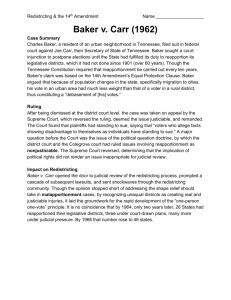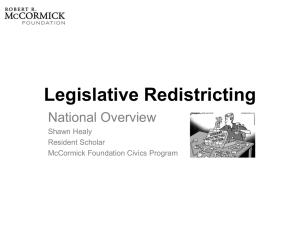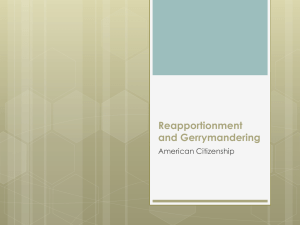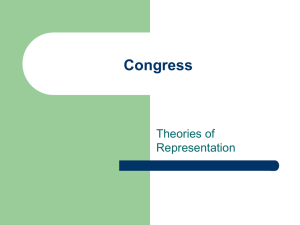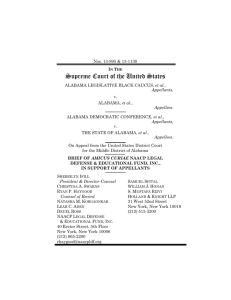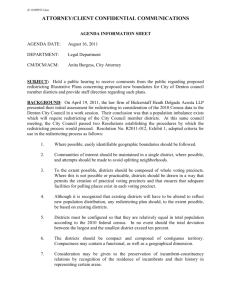Determining Judicially Acceptable Use of Race in the
advertisement
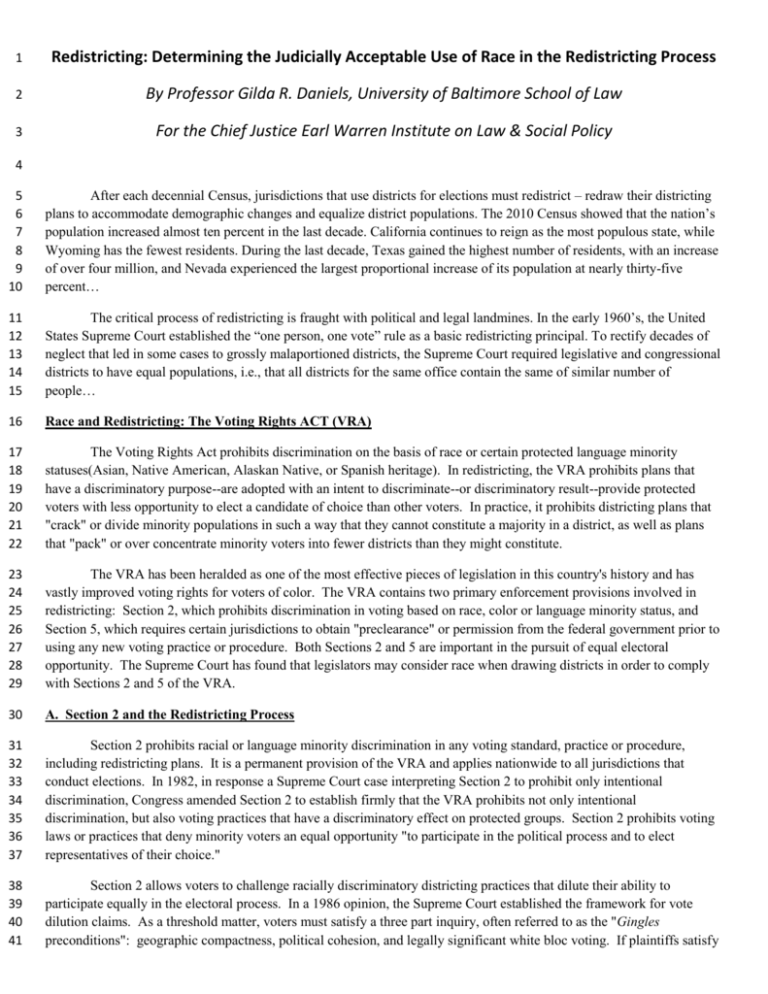
1 Redistricting: Determining the Judicially Acceptable Use of Race in the Redistricting Process 2 By Professor Gilda R. Daniels, University of Baltimore School of Law 3 For the Chief Justice Earl Warren Institute on Law & Social Policy 4 5 6 7 8 9 10 After each decennial Census, jurisdictions that use districts for elections must redistrict – redraw their districting plans to accommodate demographic changes and equalize district populations. The 2010 Census showed that the nation’s population increased almost ten percent in the last decade. California continues to reign as the most populous state, while Wyoming has the fewest residents. During the last decade, Texas gained the highest number of residents, with an increase of over four million, and Nevada experienced the largest proportional increase of its population at nearly thirty-five percent… 11 12 13 14 15 The critical process of redistricting is fraught with political and legal landmines. In the early 1960’s, the United States Supreme Court established the “one person, one vote” rule as a basic redistricting principal. To rectify decades of neglect that led in some cases to grossly malaportioned districts, the Supreme Court required legislative and congressional districts to have equal populations, i.e., that all districts for the same office contain the same of similar number of people… 16 Race and Redistricting: The Voting Rights ACT (VRA) 17 18 19 20 21 22 The Voting Rights Act prohibits discrimination on the basis of race or certain protected language minority statuses(Asian, Native American, Alaskan Native, or Spanish heritage). In redistricting, the VRA prohibits plans that have a discriminatory purpose--are adopted with an intent to discriminate--or discriminatory result--provide protected voters with less opportunity to elect a candidate of choice than other voters. In practice, it prohibits districting plans that "crack" or divide minority populations in such a way that they cannot constitute a majority in a district, as well as plans that "pack" or over concentrate minority voters into fewer districts than they might constitute. 23 24 25 26 27 28 29 The VRA has been heralded as one of the most effective pieces of legislation in this country's history and has vastly improved voting rights for voters of color. The VRA contains two primary enforcement provisions involved in redistricting: Section 2, which prohibits discrimination in voting based on race, color or language minority status, and Section 5, which requires certain jurisdictions to obtain "preclearance" or permission from the federal government prior to using any new voting practice or procedure. Both Sections 2 and 5 are important in the pursuit of equal electoral opportunity. The Supreme Court has found that legislators may consider race when drawing districts in order to comply with Sections 2 and 5 of the VRA. 30 A. Section 2 and the Redistricting Process 31 32 33 34 35 36 37 Section 2 prohibits racial or language minority discrimination in any voting standard, practice or procedure, including redistricting plans. It is a permanent provision of the VRA and applies nationwide to all jurisdictions that conduct elections. In 1982, in response a Supreme Court case interpreting Section 2 to prohibit only intentional discrimination, Congress amended Section 2 to establish firmly that the VRA prohibits not only intentional discrimination, but also voting practices that have a discriminatory effect on protected groups. Section 2 prohibits voting laws or practices that deny minority voters an equal opportunity "to participate in the political process and to elect representatives of their choice." 38 39 40 41 Section 2 allows voters to challenge racially discriminatory districting practices that dilute their ability to participate equally in the electoral process. In a 1986 opinion, the Supreme Court established the framework for vote dilution claims. As a threshold matter, voters must satisfy a three part inquiry, often referred to as the "Gingles preconditions": geographic compactness, political cohesion, and legally significant white bloc voting. If plaintiffs satisfy 42 43 these preconditions, courts must consider the totality of the circumstances to determine, considering both past and contemporary examples of discrimination, whether the political process is equally open to minority voters. 44 45 46 47 48 As we will see, states must have a compelling reason to draw a district using race as a primary factor. The Supreme Court has found adherence to the VRA to be a compelling reason. Accordingly, when redistricting, jurisdictions may consider race in order to avoid diluting voting strength in violation of Section 2. This means maintaining, or where necessary, creating majority-minority districts that meeting the Gingles criteria, i.e., geographic compactness, political cohesiveness and white bloc voting. 49 50 51 52 53 54 55 56 While Section 2 can require the creation of majority-minority districts, the Supreme Court recently found that it does not require abandoning other redistricting principles in order to create less than majority-minority districts (called crossover districts) where minority voters are less than 50% of the population but can elect candidates of their choice with some "cross over" voting from white. Because the district at issue was less than 50% African American voting age population, the Court found that it did not meet the first Gingles precondition, which requires that the minority group be geographically compact enough to constitute a majority within the district. As such, the Court rejected the state's argument that its potential Section 2 liability required it to circumvent a state redistricting criterion not to cross county borders. 57 58 59 60 61 62 Although the Court found that Section 2 did not require crossover districts or any other form of less than majority districts, the Court specifically noted that it did not prevent states from drawing such districts if they wished. In fact, the Court looked favorably on such crossover districts where voters of different races vote together, stating that "[t]he option to draw such districts gives legislatures a choice that can lead to less racial isolation, not more." Accordingly, states are free to pursue crossover districts when they are able to do so while complying with other redistricting criteria and without making race the predominant consideration. 63 64 65 66 67 They said, Section 2 prohibits the drawing of crossover or influence in lieu of majority-minority districts where they are possible. In 2006, the Supreme Court found that a plan to "unpack" a majority Latino Congressional district violated Section 2. Texas had shaved down the Latino population but not Latino voters' candidate of choice. Further, it held that the creation of a majority-minority district in another part of the state did not address the Section 2 violation involving the dismantling of the Latino district at issue. 68 Race and Redistricting: Constitutional Considerations 69 70 71 72 73 74 In the 1990's, the Supreme Court considered a string of cases dealing with Fourteenth Amendment Equal Protection challenges to majority-minority districts, often referred to as "Shaw and its progeny." While much has been written regarding the impact of these cases on the redistricting process, it is important to note from the outset that these cases did not prohibit racial considerations in redistricting. Indeed, Shaw and its progeny recognize the use of race as a redistricting principle, but caution against allowing race to become the sole or predominate reason for drawing districts in non-remedial situations. 75 76 77 78 79 80 81 82 In Shaw v. Reno, the Supreme Court considered a challenge to North Carolina's Congressional redistricting that charged that the "State had created an unconstitutional racial gerrymander" in violation of the Fourteenth Amendment. In particular, two districts were said to have been crafted "arbitrarily--without regard to considerations such as compactness, contiguousness, geographical boundaries, or political subdivisions, with the purpose to create congressional districts along racial lines and to assure the election of two black representatives to Congress." The Court concluded that because the shape of the newly drawn districts was "so bizarre," they were "unexplainable on grounds other than race" and therefore the Court would apply the most exacting standard of constitutional review--strict scrutiny. The shape of the districts caused the Court to question the constitutionality of the constructed districts. 83 84 Although the State argued that it drew the districts to avoid a VRA Section 5 violation, the Court rejected that argument and found that the plan was not narrowly tailored. It admonished covered jurisdictions to only do what is 85 86 "reasonably necessary" to avoid retrogression. Nevertheless, the Court recognized that race could serve as a redistricting consideration, but must be balanced with other traditional redistricting principles. 87 88 89 90 91 92 93 94 In subsequent cases, the Supreme Court reaffirmed that race may be a consideration in redistricting. For example, in Lawyer v. Department of Justice, the Court upheld Florida's redistricting, rejecting a challenge that race predominated because the district at issue encompassed more than one county, crossed a body of water, was oddly shaped, and had a higher percentage of black voters than other counties. The Court found that none of these factors were "different from what Florida's traditional districting principles could be expected to produce" and that race did not predominate. Moreover, in Easley v. Cromartie, the Court explained that a redistricting plan would not be held unconstitutional because the redistricting is performed with consciousness of race or because of jurisdiction deliberately designed a majorityminority district. 95 Race and Redistricting: 96 97 98 99 100 101 102 103 In summary, the VRA prohibits voting practices with discriminatory purpose or effect, including redistricting plans that dilute minority voting strength. As such, in order to avoid VRA liability, line drawing jurisdictions must ensure that the districts they draw do not dilute voting strength and are not adopted for a discriminatory purpose. The Fourteenth Amendment to the Constitution not only prohibits redistricting plans adopted with a discriminatory purpose, but also sets some limits on the degree to which race can be considered when drawing lines. Although the Supreme Court has found that when race is the predominant consideration in redistricting, strict scrutiny will apply, it has also recognized that complying with the VRA is a compelling state interest that can justify the narrow consideration and use of race as a criterion. 104 105 106 107 108 109 110 Line drawers must keep both of these considerations in mind when deciding where to draw lines. That means maintaining majority-minority districts unless demographic shifts make maintenance impossible. It also means considering demographic changes in the new Census figures to determine whether additional majority-minority districts are necessary to avoid vote dilution. In addition, even where minority populations do not rise to majority of a district, line drawers should consider whether, as a matter of policy, they want to keep minority populations together in a district by drawing crossover or influence districts and still complying with other state redistricting principles. While these districts are not VRA required, they are permitted.

